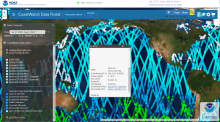Sea level Anomaly and Geostrophic Currents, multi-mission, global, optimal interpolation, gridded
The NOAA Laboratory for Satellite Altimetry's (LSA) sea surface height team produces 0.25-degree longitude/latitude Level-3 sea level anomaly (SLA) daily datasets by applying optimal interpolation to along-track satellite observations over the global ocean from a constellation of radar altimeter missions. Theses grids are produced with near-real time (3-5 hour latency) data. Geostrophic Currents are produced from the SLA and are included in the dataset.


